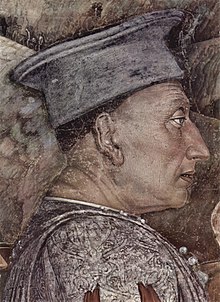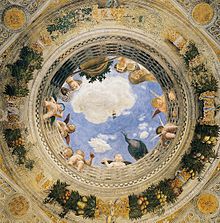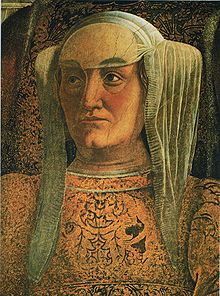Ludovico III. Gonzaga

Ludovico III. Gonzaga , called "Luigi il Turco" , (* June 5, 1412 in Mantua ; † June 12, 1478 in Goito ) was a condottiere and the son of the Marquis Gianfrancesco I. Gonzaga of the Margraviate of Mantua and his successor from 1444.
biography
Origin and family
Ludovico III. was the eldest son of Gianfrancesco I. Gonzaga , lord of Mantua from the old Italian noble family of Gonzaga , and his wife Paola Malatesta . From 1423 he, like his three brothers and two sisters, was brought up in the spirit of the Renaissance in the school of the humanist and pedagogue Vittorino da Feltre . The education of the children took place at the highest level. In addition to Latin and Greek, mathematics and music, rhetoric and philosophy were also part of the education. This education was shared with all those who were found to be worthy, regardless of rank. The Margrave's children grew up in contact with peers of different origins, with whom they often had important relationships later in life. This excellent, balanced and strict training left a clear mark on Ludovico in terms of his discipline, his dealings with intellectuals at his court and a special love for the humanities.

His military training began in the early 1930s. In 1432 he fought alongside his father in the Venetian army and it can be assumed that he remained in the pay of the Serenissima until 1436 . In November 1433, Ludovico's marriage, arranged by his father, took place with Barbara von Brandenburg, ten years his junior, from the Hohenzollern family . The importance that the father attached to this connection can be seen from the fact that the dowry was not paid by the bride's father, as usual, but by the future father-in-law. By Emperor Sigismund Gianfrancesco I. received by a payment of 12,000 Fiorini d'oro in 1433 a ranking boost to the Marquis of Mantua.
In 1436 Ludovico placed himself in the service of Filippo Maria Visconti , Duke of Milan, on the one condition that he did not have to fight his father. It appears that he took this step without his father's knowledge. Margrave Gianfrancesco must have been very angry about the first-born, because he asked the emperor for permission to change the order of succession in the margraviate in favor of his second-born son Carlo and received approval by letter of November 3, 1436. Five years later, in 1441, according to tradition, thanks to Paola Malatesta and Vittorino da Feltre, father and son were reconciled and the succession order was restored. In the same year Barbara gave birth to the long-awaited heir Federico , who was to be followed by ten more children.
Margrave of Mantua and Condottiere
In September 1444 his father died and Ludovico succeeded him as Margrave of Mantua . According to the will of the father, the area directly controlled by Ludovico represented the majority of the margravate. Areas along the western borders and in the northern part of the state went into the hands of the brothers Carlo ( Luzzara , Sabbioneta , Bozzolo ), Gianlucido ( Volta , Cavriana , Ceresara ) and Alessandro ( Castelgoffredo , Castiglione , Solferino ). Since none of the three brothers had a male heir, these assignments were temporary. With the death of his last brother Alessandro in 1466, the entire paternal inheritance came back under his rule. The margraviate of Mantua was a country impoverished by excessive spending and decades of war. The most important task for Ludovico was to curb the neighbors' desire for expansion. In 1445 he concluded a seven-year defensive alliance with the Duke of Milan , which, however, broke up in 1447 with the death of Filippo Maria Visconti . In 1446 and 1447 he conducted successful negotiations with Florence and Venice in order to secure the peace in Mantua and to avoid under all circumstances that the margraviate could become a battlefield or even a passage area for combat-ready troops from Venice or Milan. He also negotiated this with the Lords of Correggio and Mirandola and the Count of Guastalla .
Despite all efforts for peace, Ludovico was drawn into the struggles that broke out over the succession of the last Visconti in the Duchy of Milan , which was now the short-lived Ambrosian Republic . The clashes between the Milanese and the army of Venice culminated on September 15, 1448 in the Battle of Caravaggio , in which Ludovico was forced to flee. The agreement signed in Rivoltella on October 18 paved the way for Francesco Sforza to rule over Milan. While Ludovico's brother Carlo was in the service of the Ambrosian Republic, Ludovico remained in the service of the Serenissima until the end of 1449 and managed to place not only himself but also his two brothers under the protection of Venice. From July of that year he conducted negotiations with King Alfonso I of Naples , as a result of which in November 1449 he was in the service of the king as lieutenant general of the Neapolitan troops in Lombardy, with a contingent of 900 lances and 900 foot soldiers. The remuneration of 45,000 fiorini d'oro , of which 30,000 were paid immediately by the king and 15,000 were later to be collected by Milan, was extremely lucrative. The king also undertook to respect the margrave's neutrality towards the Serenissima.
Alliance with Milan and the Lodi Peace Treaty
After Francesco Sforza took over power, Ludovico signed the first of a long series of treaties with the new Duke of Milan in November 1450, in which he would serve in the event of a war with Venice. The exactly agreed amount of 82,000 ducats payable in 54 installments in the event of war and 47,000 ducats in peacetime on the one hand, and no precise details of the troop contingents to be provided by the margrave on the other hand, shows that this is actually a pact of political submission and a diplomatic alliance between Was unequal. The Peace of Lodi in 1454 marked the end of the open conflict between Milan and Venice. Thus began a phase of relative stability for Mantua as a result of the Milan alliance, which lasted until Ludovico's life. The treaties with Milan were renewed about every five years and after the death of Francesco Sforza in 1466, confirmed and continued by his successor, that year also by the King of Naples. The (later terminated) marriage contract between Ludovico's daughter Dorotea (1449–1467) and Duke Galeazzo Maria Sforza was a further step to consolidate this alliance. Even more important was the contact that Margravine Barbara had with Duchess Bianca Maria of Milan. Both women were at the forefront of their farms, and their lively correspondence and mutual visits are evidence not only of a close relationship, but also of the active role they took on during the absence of their husbands.
One of the goals of the Lega italica , created after the Peace of Lodi in August 1454 , which guaranteed mutual aid in the event of an attack on the integrity of a member state and a twenty-five year armistice, included the war against the Turks. Five years after the Ottoman conquest of Constantinople , Pius II , elected Pope in 1458 , convened a Diet of Christian Princes in Mantua the following year , the aim of which was to organize the counter-offensive of Christianity and, if possible, to recapture Constantinople. The entry of the Pope on the Prince's Day in 1459 was a major event. Even though the Princely Day was to prove essentially useless - the goal of resolving and specifically promoting coordinated action by the Italian and European states against the Turks was not achieved - this meant a significant personal success for Ludovico. On this occasion, for a few months - Pius II did not leave Mantua until January 1460 - the city became a kind of European capital where the representatives of the great royal houses gathered. Ludovico III. took advantage of the close relationships he was able to forge as a result, as well as the reputation he enjoyed with the Pope, to carry out a project that was very close to his heart - the rise of the second son Francesco to cardinal . The task of conducting negotiations in this regard was taken over by his wife Barbara, who, through the mediation of Cardinal Nikolaus von Kues and thanks to her close contacts with the Sforza in Milan and her uncle Albrecht Achilles von Brandenburg , who had also come to Mantua for the Prince's Day, and whose intercession with the emperor led to the desired success. On December 18, 1461, Francesco was elevated to the dignity of Cardinal Deacon of Santa Maria Nuova , despite some embarrassment at his young age of seventeen. Margravine Barbara also played a major role afterwards; Almost without exception, relations between Mantua and Rome for the next twenty years were based on contact between Barbara and her son Francesco.
Boom and cultural prosperity
The peacetime gave the margravate a boom, a period of relative stability and growing revenues. Ludovico III. took care of a better organization in the management of the expenditure, so he had the country divided into 52 smaller territorial districts. Between the late 1940s and early 1970s he made a series of large-scale interventions in the urban fabric with the aim of redesigning entire districts. He initiated the repair or renewal of the manorial estates and the ancient fortifications as well as the improvement of the canal and road network. He brought well-known architects to the country, including Luca Fancelli for the construction of the castle of Revere until 1478 and between 1470 and 1475 the residence of Saviola , or Bertola da Novate and Giovanni da Padova, who both built the Goito Canal and the Lock at Governolo were involved. From 1461 major renovations began on the fortress of Cavriana and the fortifications of Goito under Giovanni da Padova; from 1468 he worked at the palace of Gonzaga .
Gonzaga , tower
In the city of Mantua, Ludovico III. build a hospital in 1450. On the occasion of the Prince's Day and the Pope's visit, the construction of the Church of San Sebastiano began in 1459, based on a design by Leon Battista Alberti . The Basilica of Sant'Andrea was also built according to Alberti's plans from 1472 onwards . Between 1462 and 1464 he had the Palazzo del Podestà renovated by Luca Fancelli and between 1470 and 1473 he built the Casa del mercato and the Torre dell'Orologio (clock tower). In the late 1950s, Ludovico had already made sure that the city's central squares were paved. The expansion of Mantua into a representative residential city with stately buildings in the Renaissance style went hand in hand with a general improvement in living conditions in the medieval city center.
In anticipation of the arrival of Pope Pius II, Ludovico's attention turned from 1458 to his residence, a complex of buildings whose oldest part, the Palazzo del Capitano, dates back to the early 14th century. His father Gianfrancesco I had the building of today's Palazzo Ducale (Ducal Palace) painted by Antonio Pisanello with impressive frescoes around 1425 . Since a stay in Florence in 1447 this city was Ludovico's great role model and from 1456 he tried to poach the painter Andrea Mantegna from Padua . In 1458 Mantegna worked for him for the first time in Cavriana and Goito; the works have not been preserved due to the destruction of the castles, as has his work in Revere in 1463 and 1464. With numerous enticement offers, Mantegna received a very large house, a fixed salary, his own coat of arms and other privileges Bring artists to Mantua permanently. In 1460 Mantegna moved with his whole family to Mantua as an official court painter , but also as an art advisor and curator of art collections. He remained loyal to the city until the end of his life. The cycle of frescoes in the Camera degli sposi , which was created between 1464 and 1474, can be described as a high point of his work in Mantua .
End of life
In December 1476, Ludovico's ally Galeazzo Maria Sforza was murdered and the margrave was forced to mobilize his troops. Despite his poor health and age of 65, Ludovico appeared in person on January 6, 1477 in Milan. Through his presence, he helped guarantee the succession of Gian Galeazzo Sforza under the reign of the Duchess Bona of Savoy . The authority and reputation he enjoyed was beyond question. In March 1477, Ludovico received the Golden Rose from Pope Sixtus IV . Towards the end of the summer, his poor physical condition forced him to go to the Terme di Petriolo spa town to relax and receive treatment for recurrence of leg problems. A plague epidemic that broke out in Mantua in May 1478 forced Ludovico III. to escape to the castle of Goito, while his wife and the children sought refuge in the suburb of San Giorgio on June 1st . She left for Goito a few days later because her husband was unwell. On June 11, Barbara wrote to her children to join her because their father's condition had worsened. Ludovico III died on June 12, 1478. in Goito, not from the plague, but probably from pleurisy .
Marriage and offspring
On November 12, 1433, he married Barbara von Brandenburg (* September 30, 1422, † November 7, 1481), daughter of Margrave Johann von Brandenburg . He had eleven children with her:
- Federico I. Gonzaga (1441–1484), Margrave of Mantua since 1478 ⚭ 1463 Margaret of Bavaria (1442–1479), daughter of Duke Albrecht III.
- Francesco Gonzaga (1444--22 October 1483), cardinal since 1461
- Paola (1445-1447)
- Gianfrancesco Gonzaga (1446 - August 28, 1496) Count of Sabbioneta , Lord of Bozzolo ⚭ Antonia del Balzo (1461–1538), daughter of Pirro del Balzo , Prince of Altamura - descendants: the dukes of Sabbioneta and princes of Bozzolo, extinct 1703
- Susanna Gonzaga (1447 - December 19, 1481), nun
- Dorotea Gonzaga (1449–1467), engaged until 1466 to Galeazzo Maria Sforza (1444–1476), Duke of Milan
- Cecilia Gonzaga (1451-1478), nun
-
Rodolfo Gonzaga (* 1452; † (fallen) 1495) Lord of Castel Goffredo , Castiglione and Solferino
- ⚭ 1. 1481 Antonia Malatesta of Rimini († 1483)
- ⚭ 2. 1484 Caterina Pico della Mirandola († 1501) - descendants: the margraves and princes of Castiglione and St. Aloisius of Gonzaga
- Barbara Gonzaga (December 11, 1455 - May 31, 1503) ⚭ April 12, 1474 Eberhard I (1445–1496), Duke of Württemberg
- Ludovico Gonzaga (1458 - January 4, 1511), Bishop of Mantua 1483
- Paola Gonzaga (1463 / 64–1496) ⚭ 1478 Count Leonhard von Görz (1444–1500)
Ludovico III. with family and court (fresco by Andrea Mantegna )
| predecessor | Office | successor |
|---|---|---|
| Gianfrancesco I. |
Margrave of Mantua 1444–1478 |
Federico I. |
Web links
Remarks
- ↑ Barbara was a granddaughter of Elector Friedrich I of Brandenburg and niece of Elector Friedrich II of Brandenburg . She was only distantly related to the Emperor of the House of Luxemburg . The often found claim that she was his niece is genealogically unsubstantiated. It is probably a mix-up. Barbara's father was Margrave Johann von Brandenburg (1406–1464), brother of Elector Friedrich II., And a sister of Emperor Sigismund was also married to a Margrave Johann von Brandenburg (1369–1420), who was the brother of Friedrich I, Barbara's grandfather. Innsbruck historical studies, p.215. , Published by historians of the University of Innsbruck 1997, accessed on June 23, 2018
- ↑ a b The marriage contract concluded in 1463 between Ludovico's daughter Dorotea and the eldest son of Francesco Sforza was terminated by Galeazzo Maria Sforza after the death of the father . Contrary to a partially found marriage , the marriage was never consummated. Innsbruck historical studies, p.222 f. , Published by historians of the University of Innsbruck 1997, accessed on June 23, 2018
Individual evidence
- ↑ a b c d e f g h i j k l Isabella Lazzarini: LUDOVICO III Gonzaga, marchese di Mantova. In: Dizionario Biografico degli Italiani (DBI). Volume 66. Rome 2006. Retrieved June 21, 2018
- ↑ Innsbruck Historical Studies, p.215. , Published by historians of the University of Innsbruck 1997, accessed on June 23, 2018
- ↑ Innsbruck Historical Studies, p.222 f. , Published by historians of the University of Innsbruck 1997, accessed on June 23, 2018
- ↑ arthistoricum.net: Andrea Mantegna and the Camera degli Sposi , accessed on June 24, 2018
| personal data | |
|---|---|
| SURNAME | Gonzaga, Ludovico III. |
| ALTERNATIVE NAMES | Gonzaga, Luigi III .; Ludovico il Turco |
| BRIEF DESCRIPTION | Margrave of Mantua (1444–1478) |
| DATE OF BIRTH | June 5, 1412 |
| PLACE OF BIRTH | Mantua |
| DATE OF DEATH | June 12, 1478 |
| Place of death | Goito |
























